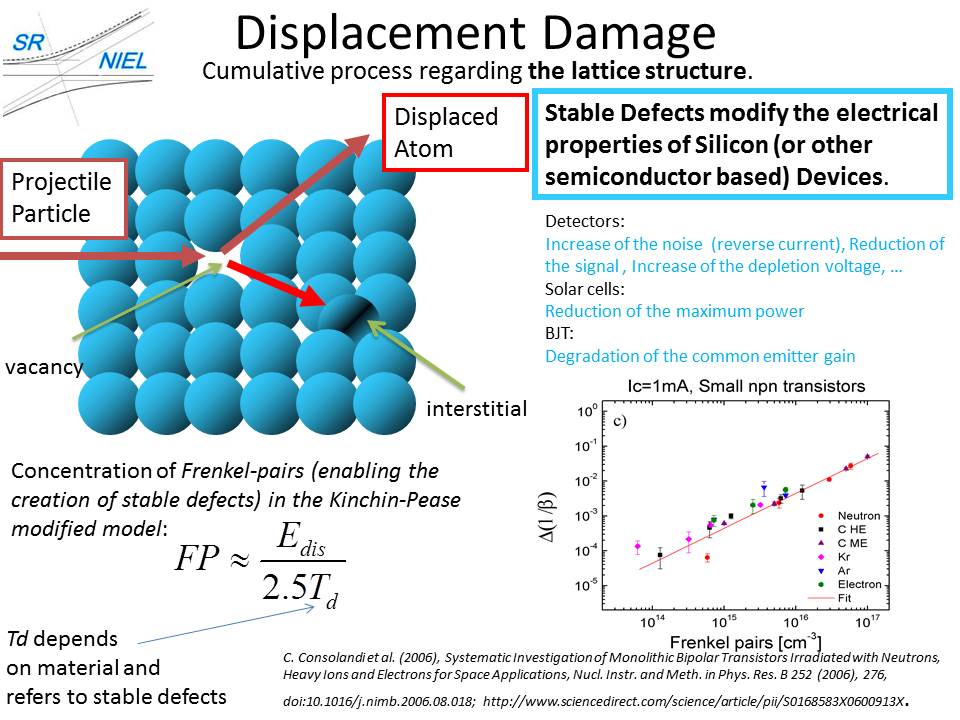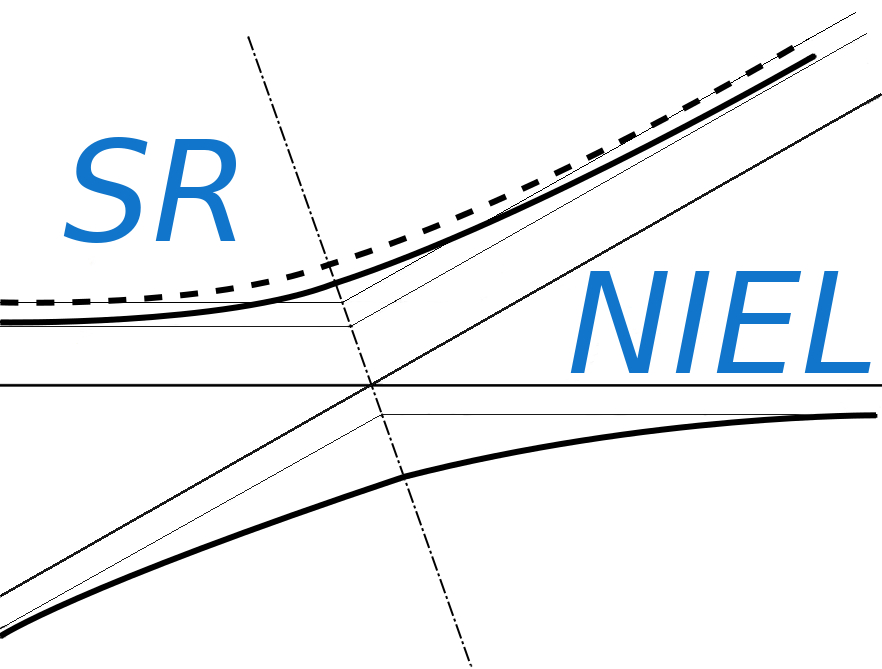
As discussed in [Consolandi et al. (2006)] (see also Sections 7.4.1, 11.1–11.1.4 of [Leroy and Rancoita (2016)] and [Leroy and Rancoita (2007)]) defects introduce trapping energy states which degrade the minority carrier lifetime. As well known, the operation of bipolar transistors results from the physical and electrical behavior of majority and minority carriers in the junctions which constitute the transistor. In fact, minority carriers are injected into the base at the emitter-base junction, are transported to the collector and, finally, are retrieved as majority carriers across the base-collector junction. For instance, the effect of radiation on bipolar devices is the reduction of the common emitter current gain, which can be described in terms of the reduction of the minority carrier lifetime in the transistor base.
The relationship between the variation of the inverse of the gain and the fast neutron fluence is provided by means of the Messenger-Spratt equation ([Messenger (1966), Messenger (1972), Messenger (1992)] and references therein):
 | , (1) |
where β and βirr are the common emitter current gain before and after the irradiation, ωT = 2πfT , fT (the so called- cut-off frequency) is the frequency at which the common emitter current gain is unity (e.g., see Section 3.10 in [Messenger and Ash (1982)], pages 67–69 of [Grebene (1984)] and [Messenger (1973)]), K is the relevant damage constant which depends also on the base resistivity (see for instance [Srour (1973)]) and Φn is the fast neutron fluence in n/cm2:
 | (2) |
where Emin value is usually taken at about 10 keV. At large particle fluences
where the damage is dominated by the atomic displacements, Δ
where λ is almost independent of the incoming particle (although it may exhibit a
slight dependence on the size of the generated point-defects cascade) but
depends on the type and on the doping profile and compensation-level of the
base.
Equation (3) is the expression for the common-emitter current gain
degradation in bipolar transistors and generalizes the Messenger-Spratt equation (e.g., the so-called generalized Messenger-Spratt equation),
originally derived for fast-neutron environment. It predicts a linear dependence of
the inverse of the gain variation on the concentration of Frenkel pairs (FP)
generated by incoming particles, i.e., it predicts an approximate NIEL scaling.
[Colder et al. (2001)] A.Colder, N.Croitoru, P.D’Angelo, M. De Marchi, G. Fallica, S. Leonardi, M. Levalois, S. Marcolomgo, P. Marie, R. Modica, P.G. Rancoita and A. Seidman (2001), Study of Radiation Effects on Bipolar Transistors, Nucl. Instrum. and
Methods in Physics B 179, 397.
[Colder et al. (2002)] A. Colder, N. Croitoru, P. D'Angelo, M.DeMarchi, G. Fallica, A.Favalli, S. Leonardi, M. Levalois, P.Marie, R. Modica, P.G. Rancoita and A. Seidman (2002), Effects of ionizing radiation
on BiCMOS components for space application, Proc. of the European
Space Component Conference (Toulose 24-27 September 2002), ESA
SP-507, 377.
[Consolandi et al. (2006)] C. Consolandi, P.D’Angelo, G. Fallica, R. Modica, R. Mangoni, S. Pensotti and P.G. Rancoita,
Systematic Investigation of Monolithic Bipolar Transistors
Irradiated with Neutrons, Heavy Ions and Electrons for
Space Applications, Nucl. Instr. and Meth. in Phys.
Res. B 252 (2006), 276, doi:10.1016/j.nimb.2006.08.018;
http://www.sciencedirect.com/science/article/pii/S0168583X0600913X.
[Grebene (1984)] A.B. Grebene (1984), Bipolar and Mos Analog
Integrated Circuit Design, John Wiley & Sons, New York.
[Holmes-Siedle and Adams (2002)] Holmes-Siedle, A. and Adams, L. (2002), Handbook of Radiation Effects - 2nd Edition,
Oxford University Press, Oxford.
[Leroy and Rancoita (2007)] C. Leroy and P.G. Rancoita (2007), Particle
Interaction and Displacement Damage in Silicon Devices operated in
Radiation Environments Reports on Progress in Physics 70, 493-625,
doi:10.1088/0034-4885/70/4/R0;
http://iopscience.iop.org/0034-4885/70/4/R01/.
[Leroy and Rancoita (2016)]
C. Leroy and P.G. Rancoita (2016), Principles of Radiation
Interaction in Matter and Detection - 4th Edition -, World Scientific.
Singapore, ISBN-978-981-4603-18-8 (printed); ISBN.978-981-4603-19-5
(ebook); https://www.worldscientific.com/worldscibooks/10.1142/9167#t=aboutBook; it is also partially accessible via google books.
[Messenger (1966)] G.C. Messenger (1966), IEEE Trans on Nucl. Sci. 13
(no. 6), 141.
[Messenger (1972)] G.C.Messenger (1972), IEEE Trans on Nucl. Sci. 55,
160.
[Messenger (1973)] G.C. Messenger, IEEE Trans. on Nucl. Scie. 20 (1973)
809.
[Messenger (1992)] G.C. Messenger (1992), IEEE Trans. on Nucl. Sci. 39,
468; see also references therein.
[Messenger and Ash (1982)] G.C. Messenger and M.S. Ash (1992), The
Effects of Radiation on Electronic Systems 2nd Edition, Van Nostrand
Reinhold Company, New York.
[Srour (1973)] J.R. Srour (1973), IEEE Trans on Nucl. Sci. 20, 190.
[Vavilov and Ukhin (1977)] V.S. Vavilov and N.A. Ukhin (1977),
Radiation Effects in Semiconductors and Semiconductor Devices (New
York: Consultants Bureau, a division of Plenum Publishing Press).
 depends linearly on the fluence also for particles other than neutrons (see
Refs. [Colder et al. (2001), Colder et al. (2002), Consolandi et al. (2006)] and, for
instance, Figure 5.3 at page 215 of Ref. [Holmes-Siedle and Adams (2002) and Figure 42 at page 124 of
Ref. [Vavilov and Ukhin (1977)]). As discussed in [Consolandi et al.
(2006), Leroy and Rancoita (2007)], Sections 7.4.1, 11.1–11.1.4 of [Leroy and
Rancoita (2016)], in absence of saturation effects we can assume that the
number of recombination centers produced in silicon is proportional to the
energy released into atomic-displacement processes (i.e., on the energy
deposited by NIEL processes). Therefore, we have that the concentration of
recombination centers is proportional to the concentration of Frenkel-pairs created
trough displacement processes and, as a consequence that, Eq. (1) can be
generalized as (see [Consolandi et al. (2006), Leroy and Rancoita (2007)],
Sections 7.4.1, 11.1–11.1.4 of [Leroy and Rancoita (2016)] and references
therein):
depends linearly on the fluence also for particles other than neutrons (see
Refs. [Colder et al. (2001), Colder et al. (2002), Consolandi et al. (2006)] and, for
instance, Figure 5.3 at page 215 of Ref. [Holmes-Siedle and Adams (2002) and Figure 42 at page 124 of
Ref. [Vavilov and Ukhin (1977)]). As discussed in [Consolandi et al.
(2006), Leroy and Rancoita (2007)], Sections 7.4.1, 11.1–11.1.4 of [Leroy and
Rancoita (2016)], in absence of saturation effects we can assume that the
number of recombination centers produced in silicon is proportional to the
energy released into atomic-displacement processes (i.e., on the energy
deposited by NIEL processes). Therefore, we have that the concentration of
recombination centers is proportional to the concentration of Frenkel-pairs created
trough displacement processes and, as a consequence that, Eq. (1) can be
generalized as (see [Consolandi et al. (2006), Leroy and Rancoita (2007)],
Sections 7.4.1, 11.1–11.1.4 of [Leroy and Rancoita (2016)] and references
therein):

(3)
References



